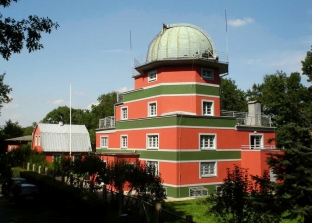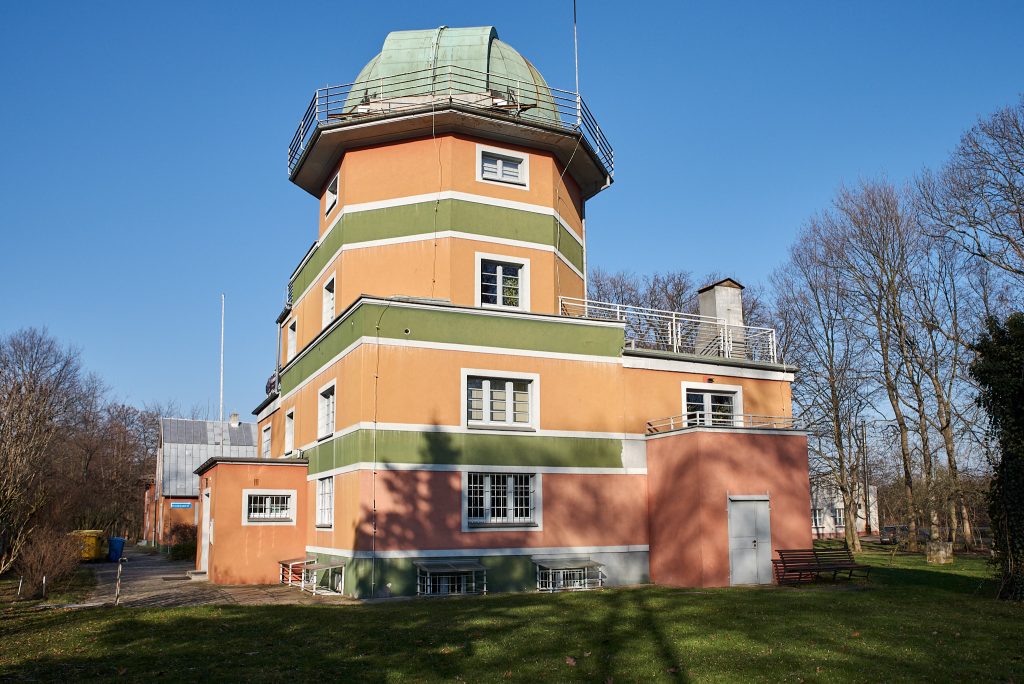
Institute of Astronomy UWr
The Institute of Astronomy is one of three institutes of the Faculty of Physics and Astronomy of the University of Wrocław. The other two institutes are: the Institute of Experimental Physics and the Institute of Theoretical Physics. The Faculty’s Dean’s Office and buildings of the Institutes of Physics are located at Maxa Borna sq. 9.
Location
The Institute of Astronomy is located in the eastern part of Wrocław in the Sępolno district, at the edge of the Szczytnicki Park, in close proximity to the ZOO, Centennial Hall, and Olympic Stadium. Current address of the Institute is: Institute of Astronomy UWr, Kopernika st. 11, 51-622 Wrocław. Part of laboratories, lecture hall, institute’s library, and employees’ offices are located in three buildings facing Kopernika st. The tallest, two-story building (in the photo above) is crowned by a dome housing a 203 mm Clark-Repsold refractor. Deeper in the area are located: new workshop building with adjacent educational pavilion, small coronagraph pavilion, and transitional instrument and vertical wheel pavilion (pictured right). On the premises of the Institute, closer to Mickiewicza st., there is also the pavilion of the Wrocław branch of the Space Research Centre PAS, i.e. the Solar Physics Division.
Organisation of the Institute
The Institute of Astronomy is made up of two divisions:
- Division of Astrophysics and Classic Astronomy (DAPaCA), head: prof. dr hab. Andrzej Pigulski
- Division of Heliophysics and Space Physics (DHPaSP), head: dr hab. Arkadiusz Berlicki, prof. UWr
The Institute has a highly skilled research and teaching staff including titular professors, habilitated doctors, and academic educators with doctoral degrees.
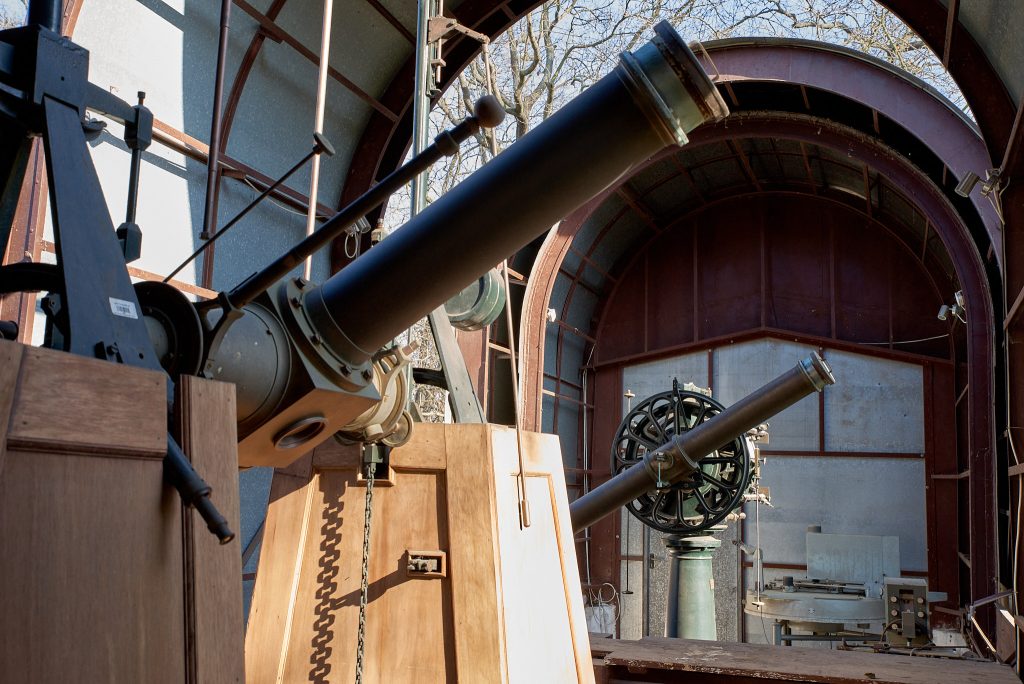
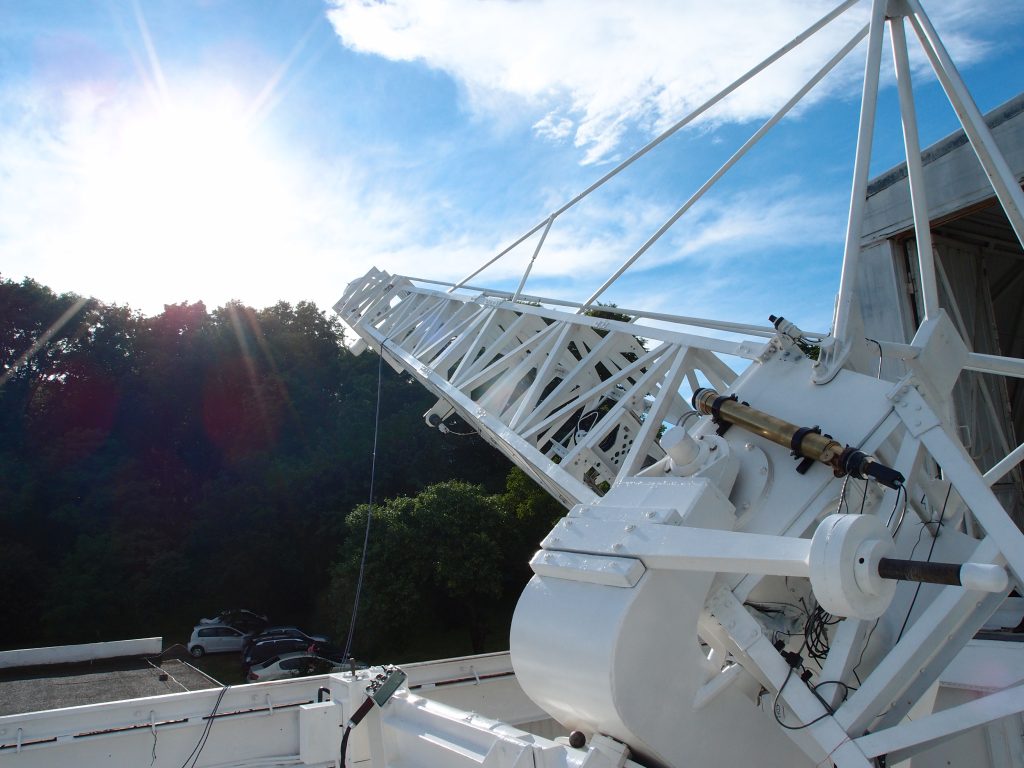
Scope of the Institute’s activities
The Institute of Astronomy fulfills a triple role:
- It operates as a field institute of the University (field of study: astronomy). Moreover, it runs Doctoral Studies as well as lectures and practices in astronomy for students of physics and geography. The Institute is also responsible for conducting doctoral and habilitation theses in astronomy.
- The observatory in Białków subordinate to the Institute operates as one of the five national astronomical observatories. The observatory currently has two world-class devices: 60-cm reflector and 53-cm coronagraph. It takes an active part in international programs and campaigns in observation of the Sun as well as stars.
- The Institute feels obliged to operate as a popularization and educational institution for primary and secondary schools in the Lower Silesia voivodeship. Since in Lower Silesia and surrounding areas there are currently no facilities specializing in popularization of astronomy, the Institute strives to fill this gap by organizing, among others, tours of the Institute combined with short lectures and a series of popular science lectures with sky shows. However, the target solution should be building a Planetarium in Wrocław which, under substantive care of the Institute, could be capable of carrying out popularization and educational activities aimed for audiences of all ages.
Teaching facilities
All teaching areas of the Institute are located in the buildings on Kopernika st. 11. Lectures, discussions, and seminars are currently held in three teaching rooms. There is a computer laboratory available to students. Moreover, some practical classes and summer internships are conducted in the UWr Observatory in Białków n/Wińsk. Lectures and part of practices in physical and mathematical subjects conducted by employees of the Institutes of Physics, however, are held in areas located at M. Borna sq. 9. Furthermore, language courses are taught at the Study of Practical Foreign Language Learning (SPFLL) at Biskupa Nankiera sq. 2/3.
Students working on master’s theses use research laboratories of the Institute and observation instruments at the Observatory in Białków.
We have an on-site reading room and institute library provided with basic academic handbooks and research publications (monographies, journals, etc.).
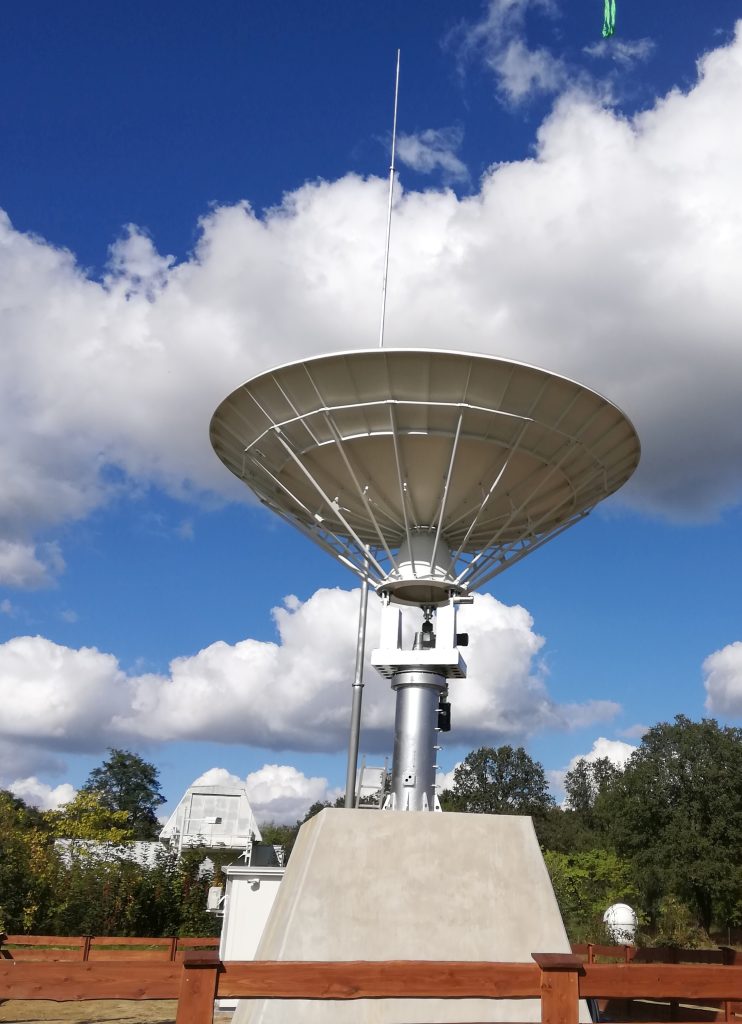
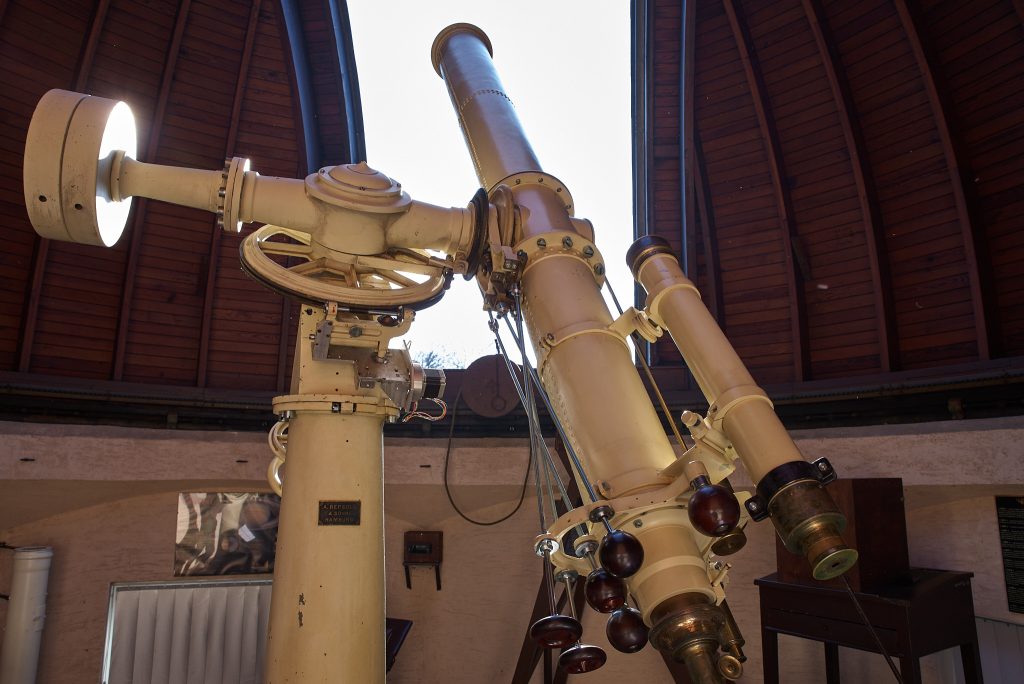
A brief history of the Institute
The Wrocław Astronomical Observatory was founded in 1791 by Anton Jungnitz. It was located in the so-called Mathematical Tower on the Main Building of the University. In the following years the Observatory was headed by: Ernst Julius Scholtz, Ludwig Bogusławski, who discovered the 1835 comet, and then Johann Galle who discovered Neptune (1846). With small instruments at its disposal, the Observatory specialized in those years in geodesic astronomy, meteorology, observations of comets and meteors, photometry of planets and planetoids, and drawing maps of the sky. At the threshold of the 20th century, Galle’s successor Julius Franz moved the Observatory to an island on the Oder near the University, installing there two new instruments, including the 8-inch Clark-Repsold refractor currently located in the Institute’s dome (pictured left). Two subsequent directors of the Observatory, Alexander Wilkens and Erich Schönberg, built in the 1920s and 1930s on the new grounds in the Szczytnicki Park (currently Kopernika st. 11) first the meridian pavilion and then current building of the Institute along with the dome housing the refractor. Erich Schönberg remained the director of the Observatory until 1945. Since 1928 astronomers in Wrocław have been making guest use of the Wutschihowscy family’s private observatory located in the village Białków near Wińsko (ca. 70 km from Wrocław). During World War II a villa was built in that area, which along with the nearby palace has been serving the astronomers to this day.
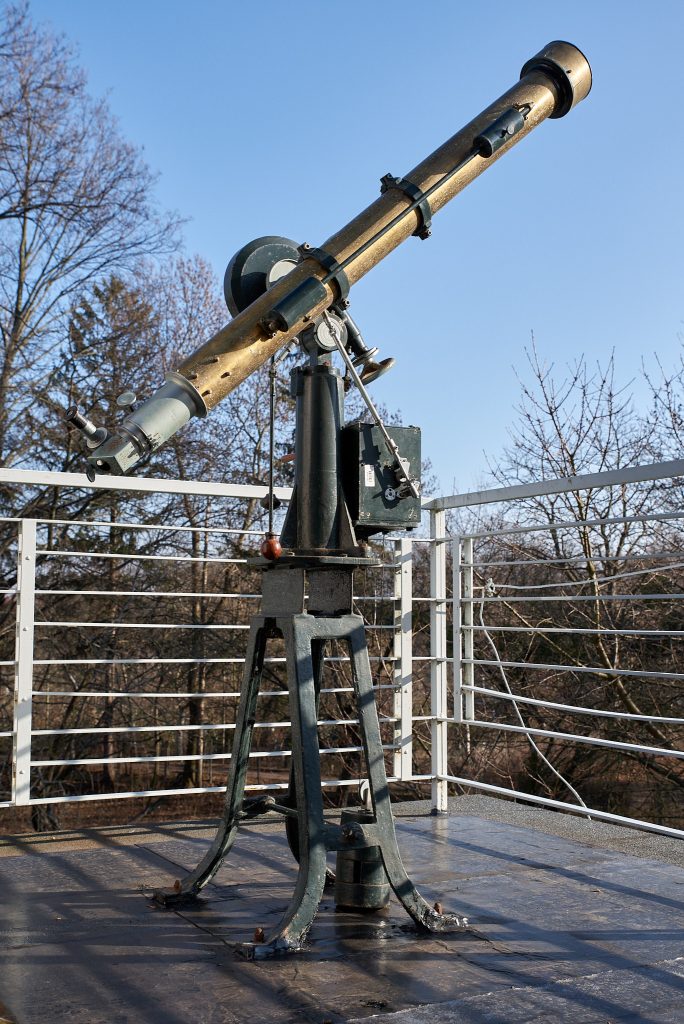
After the war the Observatory was managed by astronomers from Lviv. Prof. Eugeniusz Rybka was the first director of the Observatory (1945-1958). Using the remaining meridianal instruments he organized astrometric and photometric observations both in Wrocław and in Białków. In 1956 the Observatory was renamed to Institute of Astronomy and two years later prof. Jan Mergentaler became its new director (1958-1971). Prof. Mergentaler was the precursor of heliophysical studies that over the years became one of two main fields practiced in Wrocław. At the same time astrophysical observations were carried out, focusing on the photometry of variable stars. The initiator of those studies was prof. Antoni Opolski, the Institute’s director from 1971 to 1978. In the 1970s the idea of building an observatory on Wielka Sowa was born, but it was abandoned due to lack of funds. Two instruments bought for the planned Observatory, the 60-cm Zeiss reflector (1976) and 53-cm coronagraph (1980), were placed in Białków and are currently the Institute’s most important observational instruments.
After 1978 the directors of the Institute of Astronomy were: prof. Jerzy Jakimiec (1978-1981, 1987-1993), prof. Mikołaj Jerzykiewicz (1981-1984), doc. dr Tadeusz Jarzębowski (1984-1987), prof. Henryk Cugier (1993-2002), and prof. dr. hab. Michał Tomczak (2002-2020). Currently, the Institute’s director is dr hab. Robert Falewicz, prof. UWr.
Management of the Institute (term 2024-2028)
- Director of the Institute: dr hab. Robert Falewicz, prof. UWr
- Deputy director for general affairs: prof. dr hab. Paweł Rudawy
- Deputy director for educational affairs: dr hab. Grzegorz Kopacki

